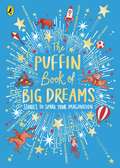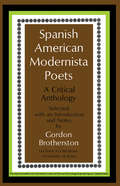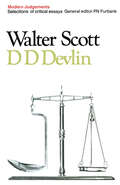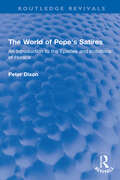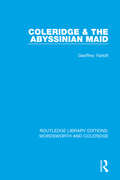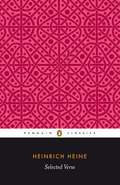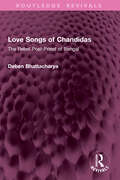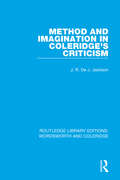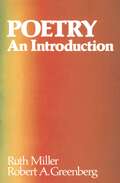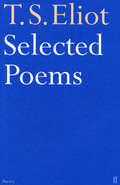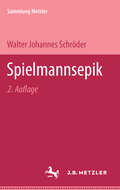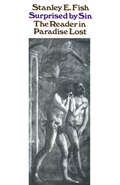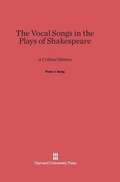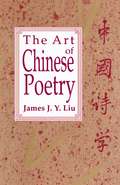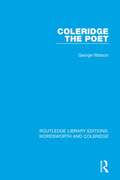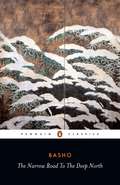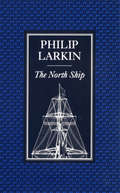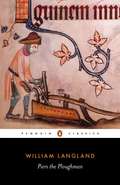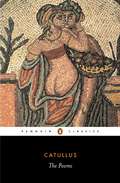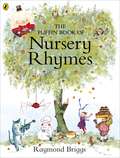- Table View
- List View
The Puffin Book of Big Dreams
by PuffinStories to spark your imagination in this beautiful collection of stories, poems and illustrations to celebrate Puffin's 80th birthday! A brand new anthology featuring extracts from classic family favourites AND brand new stories about BIG dreams from Puffin's best-loved and exciting new authors and illustrators, including:Humza Arshad & Henry White, Jeff Kinney, Jacqueline Wilson, Malorie Blackman, Nadia Shireen, Tom Fletcher, Anne Fine, Rashmi Sirdeshpande, Jamie Littler, Yassmin Abdel-Magied and Sophy Henn.This magical book also features quotes and motivational pieces from brilliant inspiring leaders, scientists and actors on their own BIG dreams. 5% of the RRP from this book will go to the National Literacy Trust, to help them continue their life-changing work.
Spanish American Modernista Poets: A Critical Anthology
by Gordon BrotherstonSpanish American Modernista Poets: A Critical Anthology presents the major works of some of Latin America’s important modernist poets. The titled dedicates a whole chapter to a specific personality. Each chapter of the text provides a short biographic account of the poet, and then proceeds to presenting the major works of the poet. The book will be of great use to individuals of have a keen interest in literary arts, particularly poetry.
The World of Pope's Satires: An Introduction to the Epistles and Imitations of Horace (Routledge Revivals)
by Peter DixonFirst published in 1968, The World of Pope’s Satires is a stimulating and challenging book showing how the satires written by Pope during the 1730s were not only expressions of his own .poetic personality but were also responsive to the habits and attitudes of the age. The author considers Pope’s uses of some current conversational technique (especially that of ‘raillery’) and of the closely related social ideal of the cultivated gentleman. Pope’s regard for certain personal attributes and moral values – notably hospitality, integrity, friendship, charity and self-knowledge – is examined in two ways; as it expresses itself positively in the satires, and as it is defined negatively by his antipathy towards courtly self-seeking and hypocrisy, contemporary manifestations of acquisitiveness, and the pride associated with neo-stoicism. The final chapter is wide ranging and shows that although Pope is at times representative, and therefore limited, in his response to the pressures and uncertainties of the age, his satires live because of the subtlety of his treatment of such Augustan commonplaces as Order and Balance and the passion and spirit of his writing. This will be an interesting read for students of English literature.
The World of Pope's Satires: An Introduction to the Epistles and Imitations of Horace (Routledge Revivals)
by Peter DixonFirst published in 1968, The World of Pope’s Satires is a stimulating and challenging book showing how the satires written by Pope during the 1730s were not only expressions of his own .poetic personality but were also responsive to the habits and attitudes of the age. The author considers Pope’s uses of some current conversational technique (especially that of ‘raillery’) and of the closely related social ideal of the cultivated gentleman. Pope’s regard for certain personal attributes and moral values – notably hospitality, integrity, friendship, charity and self-knowledge – is examined in two ways; as it expresses itself positively in the satires, and as it is defined negatively by his antipathy towards courtly self-seeking and hypocrisy, contemporary manifestations of acquisitiveness, and the pride associated with neo-stoicism. The final chapter is wide ranging and shows that although Pope is at times representative, and therefore limited, in his response to the pressures and uncertainties of the age, his satires live because of the subtlety of his treatment of such Augustan commonplaces as Order and Balance and the passion and spirit of his writing. This will be an interesting read for students of English literature.
Coleridge and the Abyssinian Maid (RLE: Wordsworth and Coleridge)
by Geoffrey YarlottFirst published in 1967, this book seeks to show the causes which led to Coleridge’s breakdown in 1802 and to indicate how his views on poetry changed as a result of it. The approach is selective in that it only focuses on one part of Coleridge’s life (roughly 1793-1810); however the author attempts to relate a number of different areas of his activity and to trace his emotional and moral development more closely than might be possible in a full-scale biography. The account of Coleridge’s life ends in 1810, when his relationship with the two key figures in his life Asra and Wordsworth had ruptured, as this reflected which of Coleridge’s Notebooks were available at the time.
Coleridge and the Abyssinian Maid (RLE: Wordsworth and Coleridge)
by Geoffrey YarlottFirst published in 1967, this book seeks to show the causes which led to Coleridge’s breakdown in 1802 and to indicate how his views on poetry changed as a result of it. The approach is selective in that it only focuses on one part of Coleridge’s life (roughly 1793-1810); however the author attempts to relate a number of different areas of his activity and to trace his emotional and moral development more closely than might be possible in a full-scale biography. The account of Coleridge’s life ends in 1810, when his relationship with the two key figures in his life Asra and Wordsworth had ruptured, as this reflected which of Coleridge’s Notebooks were available at the time.
Heine: Selected Verse
by Heinrich Heine Peter Branscombe'One of the first men of this century' is how Heine described himself when he claimed to have been born in the early hours of 1800. It was typical of Heine to create this humorous doubt - he was in fact born in 1797. He was a restless and homeless poet, a Jew among Germans, a German in Paris, a rebel among the bourgeoisie and always, as his famous doppelgänger poems show, a man divided against himself. This selection, with the German originals accompanied by English prose translations, provides the perfect introduction to Heine. He can be magnificent as an acute, irreverent commentator on politics and current events, though his genius most often strikes home in the poems filled with despair, or sensuality, or sweetness, or self-mockery, in which he draws out the whole gamut of emotions provoked by love and immanent death.
Love Songs of Chandidas: The Rebel Poet-Priest of Bengal (Routledge Revivals)
First published in 1967, Love Songs of Chandidās provides an informative introduction which makes vividly clear the importance of Chandidās to the Indian peasant masses. As the author tells us, the traveller through the Birbhum area of Bengal hears Chandidās everywhere, in the villages, in the fields, on the roads. Night after night, the people gather in the temple courtyards or on the village greens to listen to professional ‘Kirtan’ singers sing his songs of the divine love of Radha and Krishna. The influence of Chandidās on contemporary Bengali literature is equally important, his songs having enriched the work of great poets such as Rabindranath Tagore, Govindadas, and many others. The author also discusses the interesting topic of the Sahaja (‘spontaneity’) movement in Indian faith and literature, as manifested in the songs of Chandidās, and the worship of love-making, divine and human, as an important aspect of this faith. This book will be of interest to students of literature, music, history, cultural studies and South Asian studies.
Love Songs of Chandidas: The Rebel Poet-Priest of Bengal (Routledge Revivals)
by Deben BhattacharyaFirst published in 1967, Love Songs of Chandidās provides an informative introduction which makes vividly clear the importance of Chandidās to the Indian peasant masses. As the author tells us, the traveller through the Birbhum area of Bengal hears Chandidās everywhere, in the villages, in the fields, on the roads. Night after night, the people gather in the temple courtyards or on the village greens to listen to professional ‘Kirtan’ singers sing his songs of the divine love of Radha and Krishna. The influence of Chandidās on contemporary Bengali literature is equally important, his songs having enriched the work of great poets such as Rabindranath Tagore, Govindadas, and many others. The author also discusses the interesting topic of the Sahaja (‘spontaneity’) movement in Indian faith and literature, as manifested in the songs of Chandidās, and the worship of love-making, divine and human, as an important aspect of this faith. This book will be of interest to students of literature, music, history, cultural studies and South Asian studies.
Method and Imagination in Coleridge's Criticism (RLE: Wordsworth and Coleridge)
by J.R. de J. JacksonFirst published in 1969, this book places Coleridge’s literary criticism against the background of his philosophical thinking, examining his theories about criticism and the nature of poetry. Particular attention is paid to the structure of Biographia Literaria, Coleridge’s distinction between Imagination and Fancy, his definitions of the poetic characters of Shakespeare and Wordsworth, his analysis of the mental state of audiences in theatres, and his interpretations of Paradise Lost, Hamlet and Aeschylus’ Prometheus. The emphasis throughout is on how Coleridge thought rather than what he thought and the process rather than the conclusions of his criticism.
Method and Imagination in Coleridge's Criticism (RLE: Wordsworth and Coleridge)
by J.R. de J. JacksonFirst published in 1969, this book places Coleridge’s literary criticism against the background of his philosophical thinking, examining his theories about criticism and the nature of poetry. Particular attention is paid to the structure of Biographia Literaria, Coleridge’s distinction between Imagination and Fancy, his definitions of the poetic characters of Shakespeare and Wordsworth, his analysis of the mental state of audiences in theatres, and his interpretations of Paradise Lost, Hamlet and Aeschylus’ Prometheus. The emphasis throughout is on how Coleridge thought rather than what he thought and the process rather than the conclusions of his criticism.
Poetry: An Introduction
by Ruth Miller and Robert A. GreenbergThis book provides an introduction to the elements of poetry, formulates a series of contexts for the interpretation of poems, and offers a substantial anthology. Its purpose is to enable students to read poems with understanding and pleasure and to provide them with a basic vocabulary for analysing and talking about poems.
Selected Poems of T. S. Eliot: Selected Poems (Faber Poetry Ser.)
by T. S. EliotAs a poet, editor and essayist, T. S. Eliot was one of the defining figures of twentieth century poetry. This selection, which was made by Eliot himself, includes many of his most celebrated works, including The Love Song of J. Alfred Prufrock and The Waste Land.Other volumes in this series: Auden, Betjemen, Plath, Hughes and Yeats.
Surprised by Sin: Reader in "Paradise Lost"
by Stanley Eugene FishStanley Fish's Surprised by Sin argues here that Paradise Lost is a poem about how its readers came to be the way they are and therefore the fact of their divided responses makes perfect sense.
The Vocal Songs in the Plays of William Shakespeare: A Critical History (PDF)
by Peter J. SengThe Vocal Songs in the Plays of William Shakespeare: A Critical History
The Art of Chinese Poetry
by James J. LiuThis concise introduction to Chinese poetry serves as a primer for English-speakers eager to expand their understanding and enjoyment of Chinese culture. James J. Y. Liu first examines the Chinese language as a medium of poetic expression and, contrary to the usual focus on the visual qualities of Chinese script, emphasizes the auditory effects of Chinese verse. He provides a succinct survey of Chinese poetry theory and concludes with his own view of poetry, based upon traditional Chinese concepts. "[This] books should be read by all those interested in Chinese poetry."—Achilles Fang, Poetry "[This is] a significant contribution to the understanding and appreciation of Chinese poetry, lucidly presented in a way that will attract a wide audience, and offering an original synthesis of Chinese and Western views that will stimulate and inspire students of poetry everywhere."—Hans H. Frankel, Harvard Journal of Asiatic Studies "This is a book which can be recommended without reservation to anyone who wants to explore the world of Chinese poetry in translation."—James R. Hightower, Journal of Asian Studies
Coleridge the Poet (RLE: Wordsworth and Coleridge)
by George WatsonFirst published in 1966. Despite the intense interest in Coleridge in the twentieth century, this book represents the first study of Coleridge’s poetry to be published in Britain. It is also the first to be based upon the conclusion that Coleridge’s greatness as a poet is a matter of achievement rather than aspiration and to argue that his literary career was nearly half a century long, consisting of more than just well-known texts like The Ancient Mariner and Kubla Khan. The author argues the formality of the romantic achievement and its success in creating whole and fully realised poems in the established literary kinds.
Coleridge the Poet (RLE: Wordsworth and Coleridge)
by George WatsonFirst published in 1966. Despite the intense interest in Coleridge in the twentieth century, this book represents the first study of Coleridge’s poetry to be published in Britain. It is also the first to be based upon the conclusion that Coleridge’s greatness as a poet is a matter of achievement rather than aspiration and to argue that his literary career was nearly half a century long, consisting of more than just well-known texts like The Ancient Mariner and Kubla Khan. The author argues the formality of the romantic achievement and its success in creating whole and fully realised poems in the established literary kinds.
The Narrow Road to the Deep North and Other Travel Sketches
by Matsuo Basho'It was with aweThat I beheldFresh leaves, green leaves,Bright in the sun'When the Japanese haiku master Basho composed The Narrow Road to the Deep North, he was an ardent student of Zen Buddhism, setting off on a series of travels designed to strip away the trappings of the material world and bring spiritual enlightenment. He writes of the seasons changing, the smell of the rain, the brightness of the moon and the beauty of the waterfall, through which he sensed the mysteries of the universe. These writings not only chronicle Basho's travels, but they also capture his vision of eternity in the transient world around him.Translated with an Introduction by Nobuyuki Yuasa
The North Ship
by Philip LarkinThe North Ship, Philip Larkin's earliest volume of verse, was first published in August 1945. The introduction, by Larkin himself, explains the circumstances of its publication and the influences which shaped its contents.
Piers the Ploughman: With Notes And A Glossary By Thomas Wright
by William Langland J. GoodridgeWritten by a fourteenth-century cleric, this spiritual allegory explores man in relation to his ultimate destiny against the background of teeming, colorful medieval life.
The Poems (Penguin Classics Series)
by CatullusOne of the most versatile of Roman poets, Catullus wrote verse of an almost unparalleled diversity and stylistic agility, from the brevity of the epigram to the sustained elegance of the elegy. This collection contains all of Catullus' extant work and includes his lyrics to the notorious Clodia Metelli - married, seductive and corrupt - charting the course from rapturous delight in a new affair to the torment of love gone sour; poems to his young friend Iuventius; and longer verse, such as the extraordinary tale of Attis, a Greek youth who castrates himself in a fit of religious ecstasy. Ranging from the tender, moving and passionate to the vicious and even obscene, these are poems of astonishingly modern force and content.
The Puffin Book of Nursery Rhymes
by Raymond BriggsWith over 250 nursery rhymes, including both well-known favourites and hidden gems, this collection has something for every child. Beautiful illustrated by Raymond Briggs, the much-loved creator of the Snowman, this revised edition of a famous classic first won the Kate Greenaway in 1966 and is now available again for a whole new generation.
